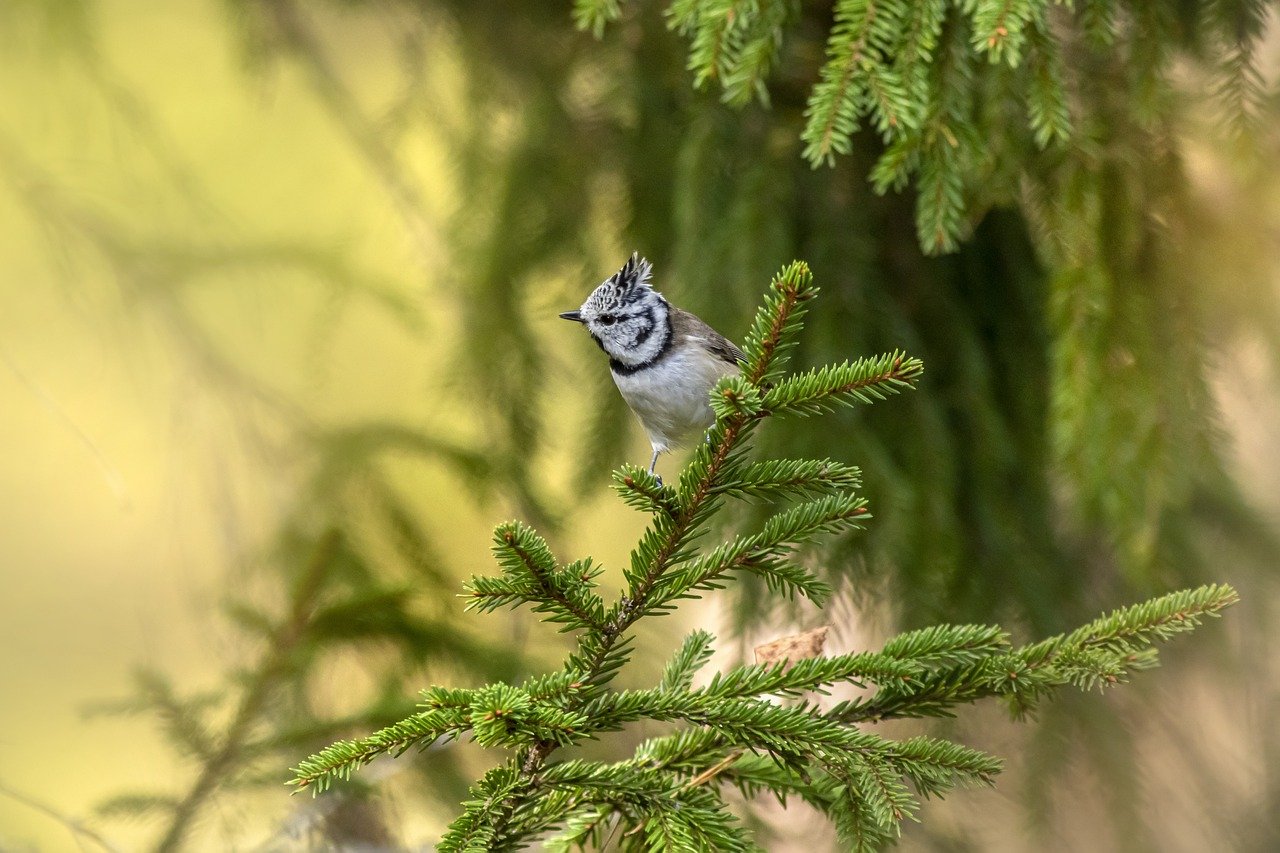The European Crested Tit (Lophophanes cristatus) is a charming and distinctive small bird known for its unique crest and lively personality. It is a resident species in various parts of Europe, particularly in coniferous forests.
Description
- Appearance:
- Size: The European Crested Tit measures approximately 11-12 centimeters (4.3-4.7 inches) in length, with a wingspan of 18-22 centimeters (7.1-8.7 inches).
- Coloration: It has a striking appearance with a prominent black crest on its head, white cheeks, and a mix of grey and brown feathers on its body. The back is brown with white edges, while the underparts are paler.
- Bill: The bill is short and pointed, suited for feeding on insects and seeds.
Habitat
- Distribution: The European Crested Tit is found across a wide range in Europe, including parts of Spain, France, Germany, and eastern Europe up to Scandinavia and the Baltic states.
- Preferred Environment: It inhabits coniferous forests, particularly those with mature trees and dense undergrowth. It can also be found in mixed woodlands with coniferous trees.
Behavior and Ecology
- Diet:
- Insectivorous and Granivorous: The diet primarily consists of insects and spiders, particularly during the breeding season. In winter, it also feeds on seeds, especially pine seeds.
- Foraging: European Crested Tits are known for their acrobatic feeding habits. They often hang upside down while searching for food and are adept at using their strong bill to extract seeds and insects from conifer cones.
- Breeding:
- Nesting: They build their nests in tree cavities or abandoned woodpecker holes, often lining them with feathers, moss, and spider silk. The nests are well-hidden and provide protection from predators.
- Incubation: The female incubates the eggs for about 14-16 days. After hatching, both parents feed the chicks, which fledge after about 18-21 days.
- Behavior:
- Social Structure: European Crested Tits are generally seen in small family groups or pairs. They can be quite active and vocal, using a variety of calls and songs to communicate.
- Territoriality: They may be territorial, particularly during the breeding season, defending their nesting sites from other birds.
Conservation
- Status: The European Crested Tit is currently not considered threatened. It has a stable population in its range, although habitat destruction and changes in forest management can impact its numbers.
- Conservation Efforts: Maintaining healthy coniferous forest habitats is crucial for their conservation. Efforts include protecting forest areas and ensuring the availability of suitable nesting sites.
Observing European Crested Tits
- Best Times: They can be observed year-round in their habitat. They are more active and vocal during the breeding season, which typically occurs in spring and early summer.
- Watching Tips: Look for them in mature coniferous forests. Their distinctive crest and lively behavior make them relatively easy to spot once you are in their habitat. Listening for their high-pitched calls can also help locate them.
Interesting Facts
- Crest: The black crest of the European Crested Tit is one of its most distinctive features, adding to its overall charm and making it easily recognizable.
- Adaptability: Despite its specific habitat preferences, the European Crested Tit can adapt to a variety of forest environments as long as there are sufficient conifers and suitable nesting sites.
- Behavior: The bird’s acrobatic feeding habits and energetic movements make it a fascinating subject for bird watchers and nature enthusiasts.
Summary
The European Crested Tit (Lophophanes cristatus) is a small, striking bird known for its distinctive black crest and lively behavior. Inhabiting coniferous forests across Europe, it is an adaptable species that thrives in suitable woodland environments. Observing this bird offers a glimpse into the unique adaptations and behaviors of woodland avifauna. Its charming appearance and energetic nature make it a favorite among bird watchers.
Visited 895 times, 4 visit(s) today
Views: 1043
Subscribe to the newsletter:
